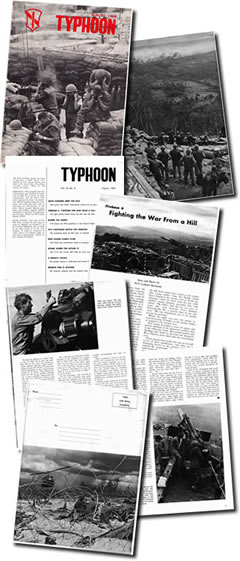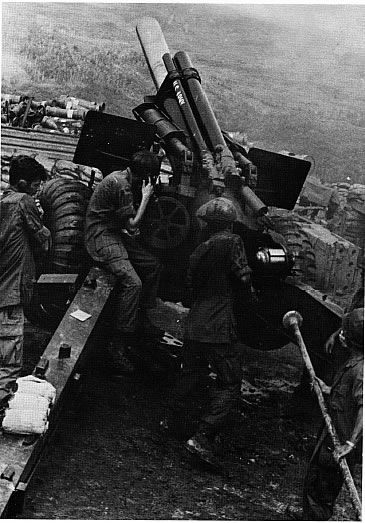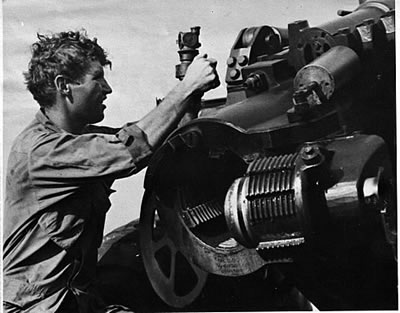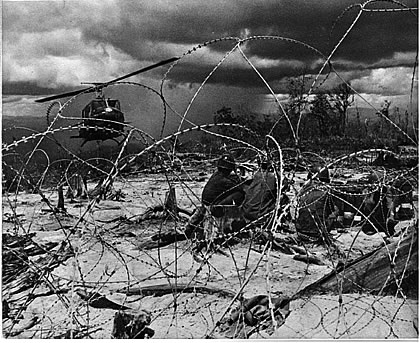 The snap of a twig 10 meters from the barbed-wire perimeter was the only warning. The ears of one of the Mobile Strike Force Montagnards on guard perked at the sound of movement a few feet away. In the evening drizzle atop Firebase 6 in the Central highlands the men of Bravo Battery, 1st Battalion of I Field Force's 92nd Artillery were asleep, their guns quiet. The mist-enshrouded hill is usually tranquil at night, unless a late-evening fire mission shatters that silence with a thunderous volley of rounds from steaming gun tubes. The snap of a twig 10 meters from the barbed-wire perimeter was the only warning. The ears of one of the Mobile Strike Force Montagnards on guard perked at the sound of movement a few feet away. In the evening drizzle atop Firebase 6 in the Central highlands the men of Bravo Battery, 1st Battalion of I Field Force's 92nd Artillery were asleep, their guns quiet. The mist-enshrouded hill is usually tranquil at night, unless a late-evening fire mission shatters that silence with a thunderous volley of rounds from steaming gun tubes.
But within seconds after the accidental warning reached the guard's ears, the calm night air erupted with noise as the first of several satchel charges landed inside the perimeter and exploded. Roused from their sleep, the artillery-men scrambled from sand-bagged bunkers to their 155mm howitzers through a barrage of small arms fire. Setting the howitzers at nearly maximum elevations to drop the rounds on the hillside just beyond the perimeter, the artillery-men began firing. While the Montagnards manned the perimeter bunkers, holding off the VC sapper squad's attack, the Americans on the hill fired round after round at the enemy. One young soldier from the Mobile Strike Force blazed at the enemy with a M-60 machinegun which he fired from his hip while another young defender provided him with ammo. “He didn't look like he was over 12 years old,” said Sergeant Terry Klingel, Edwardsville , Ill. , a section chief of one gun crew. “He is determined not to let anyone in past his position.”
Before the night was over, the enemy retreated leaving 36 bodies in the nearby bushes or tangled in the barbed wire.
This attack preceded a series of rocket and mortar shellings at the American artillery base in the following weeks. But ground probes and shellings also failed to decrease the firepower Bravo Battery pours daily into the surrounding area.
These attacks have made the men on the hill aware of their significance: that they are a damaging barrier to the enemy's attempts to control the countryside. They know the fear and tension that accompanies their role in helping to secure the area around them.
 PHOTO CAPTION: While one man shoves the 100-pound shell into the tube, another artilleryman prepares to ram it into place with the rammer staff. The section chief listens to the order from the Fire Direction Center to fire on the enemy in the valley below. PHOTO CAPTION: While one man shoves the 100-pound shell into the tube, another artilleryman prepares to ram it into place with the rammer staff. The section chief listens to the order from the Fire Direction Center to fire on the enemy in the valley below.
Firebase 6, sitting on a ridge with a view of Dak To to the east and Ben Het to the west, has become a prime artillery and air strike coordination center for South Vietnamese forces operating in this northwestern corner of II Corps. The hilltop has been the site of an artillery firebase for a year, initially supporting the 4 th Infantry Division soldiers who were blocking the movement of NVA regulars from Cambodian and Laotian sanctuaries just across the borders. Bravo Battery moved to the hill in January to support the ARVN forces now operating in this area.
Despite the change of the troops around it, Bravo Battery remains essentially static. Only the variations in meals, locations of bunkers and the directions the men point their howitzers on fire missions break the routine.
“When we're lucky,” said Corporal Anthony Peccaris (EDITOR'S NOTE spelling correction: Peccari) , Philadelphia , “something different happens that helps us take our minds off the time. When we first got here we got invaded by rats—I mean big ones. We had to medevac a couple of guys to Pleiku to get some shots. The rats bit them while they slept. Another time, the whole sky became black with a swarm of flying bugs. They didn't bother us. They were just something different to think about other than the rounds we lug or the bunkers we live in.”
The work day for Firebase 6 artillerymen is not confined to a single day or night shift. One tired soldier, who was up most of the night, said, “if we get six hours of sleep a night, some of us feel like having a party to celebrate. Sometimes we get as little as two to four hours a night—if we're lucky.”
In the mornings, with several of the crews still manning guns after all-night fire missions, one man from each gun crew walks to the mess hall, with its wooden walls and loose canvas ceiling that flaps in the wind. One of the cooks, a blond- and curly-haired young soldier, serves coffee, while another prepares the French toast and bacon and eggs. The man from the gun crew brings the other members of his section the coffee first. While the crew gulps the warm coffee, the crooked line that winds around the mess hall lengthens as the men who managed to get a full night's sleep crawl out of cramped bunkers and trudge toward the chow.
 The men of the gun section view chow time as something other than a rest period. “Most of us hat it when chow comes around,” said Private First Class William Gilkinson, New York . “We get to relaxing a bit, all set to enjoy the food, when we always get a fire mission. It seldom fails. It's almost a game with us now.” Lighthearted wagering on whether an interruption will come usually accompanies the best of meals. The men of the gun section view chow time as something other than a rest period. “Most of us hat it when chow comes around,” said Private First Class William Gilkinson, New York . “We get to relaxing a bit, all set to enjoy the food, when we always get a fire mission. It seldom fails. It's almost a game with us now.” Lighthearted wagering on whether an interruption will come usually accompanies the best of meals.
PHOTO CAPTION: With the words “fire mission” still in the air an artilleryman adjusts the deflection of his 155mm howitzer. EDITOR'S NOTE: The artilleryman in the photo is PFC Bill Gilkinson who is quoted in the article. I have verified that it is Bill Gilkinson; he lives less than an hours drive from me and we have exchanged email. I suggest identifying him in the photo caption.
After breakfast, if there is no fire mission for a particular gun section, the men begin cleaning up or rebuilding bunkers. While most of the men are busy policing the hill, burning used powder bags or cleaning their howitzers, one soldier sets up a barber shop next to one of the underground bunkers and a line of artillerymen needing haircuts quickly forms.
During spare moments or breaks from work, the men sit around their guns and talk about what they see. “You try to find something to see, something different,” one man said, “but all you can see are the same mountains, the same ridges, the same bomb craters down in the valley. You look at the bunkers; you take time out every time a resupply ‘slick' comes in, hoping you will get mail or something you need. You look at the Montagnards along our perimeter, and all they ever seem to be doing is washing clothes or fixing a meal. It's always the same. You really get the feeling after a while that this is your home.”
While a serious mood prevails during a fire mission, levity and joking continue during meals, mail call, and the evenings when the men return to their crowded bunkers. They concoct mixtures of cool-ade and lemonade, mixed with luke-warm water—“It tastes good, it really does.”—and talk about the letter from Mary or the R&R they went on last month.
The 155mm howitzers which fire all hours rattle the men's thoughts. “You can't prepare yourself or brace yourself for the firing. It seems one of the six guns on this hill is always firing; or if there is a lapse sometime, the blast of the guns will pop up at the darndest times,” said Private First Class Nick Garcia, a native Californian, resting at night in his hootch. Ten seconds later a loud bomb-blast stirred him into discourse of four-letter words.
 “It's unrelenting, but after a while on the hill, you get used to the shock and the dust that always falls on you from the sides of the bunker when you're sleeping,” shrugged another soldier, brushing a coat of dust from his face. “It's getting to be a part of the game, it's routine,” he continued, trying to laugh it off. “It's unrelenting, but after a while on the hill, you get used to the shock and the dust that always falls on you from the sides of the bunker when you're sleeping,” shrugged another soldier, brushing a coat of dust from his face. “It's getting to be a part of the game, it's routine,” he continued, trying to laugh it off.
“The thing is,” added First Lieutenant Michael S. Wolters, Westover A.F.B., Mass. , “we know we haven't got it as bad as those ARVNs down there. The men feel they're really helping. One time we got word back up here from an ARVN commander who personally thanks us for saving his troops from an ambush. We gave them support when they needed it. It helps a lot knowing that what you're doing is helping to win this war.”
After lunch, the pace slows a bit as the sun drinks perspiration from deeply tanned backs. The sweat runs down in streams, drenching fatigue pants. “It's cool,” on man bluffed.
Some days when there is no fire mission to prepare for, the artillerymen take front row seats for the B-52 bombing raids in the valleys and forests below. Though the bombs fall miles away, the hill shakes with the tremors of their impact. “It feels like an earthquake,” one man said. “Yeah, or like some weird carnival ride,” added another.
PHOTO CAPTION: Like men of the Old West waiting for the stage to come in, Rangers on Firebase 5 in the Central Highlands take a break to see what comes in on the next chopper. It could be canisters of water, boxes of C-rations, mail, or even some replacements. (Photo by Sp5 Thomas B. Lykens)
When the dust finally drifts away with the wind, the conversation turns to how bad it must be down there when the bombs are falling. Then the ominous order of “Fire Mission” stirs the watching men into action. They turn their howitzers in the right direction, load 100-pound rounds into the tube and “fire…fire…fire…”
Almost daily there are the F-4 or F-100 air raids, mincing up even more of what has been bombed and kneaded by the artillery and the B-52 air strikes. The artillerymen pause to watch the jets streak overhead, cavorting in the sky like a couple of kittens, playing their deadly game of diving, bombing, and strafing.
But for the men of Firebase 6, there are always more shells to carry and load, more loud noises and sleepless nights to endure. PFC Tom Neale, Detroit , Mich. , said, “What I'd like to do is take one of the ‘Joes' (projectiles) home with me in my hold baggage, put it over my mantel and just sneer at it all day. I must have carried thousands of them already.”
Some of the shortimers still recall names of former firebases such as Swinger and Impossible where Bravo Battery once supported allied operations. But for now, and until some new guys take their places, this vital little hill will be their home. And, as PFC Neale said, “You know, I wouldn't trade my place on this hill. I'd rather be up here than down in Dak To or Pleiku. Up here you see what you're doing; you feel proud of helping the ARVNs fight this war. Most of the guys feel the same way.”
|